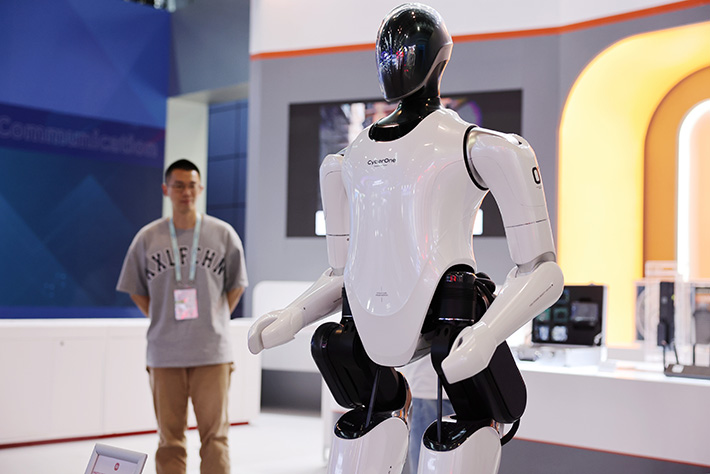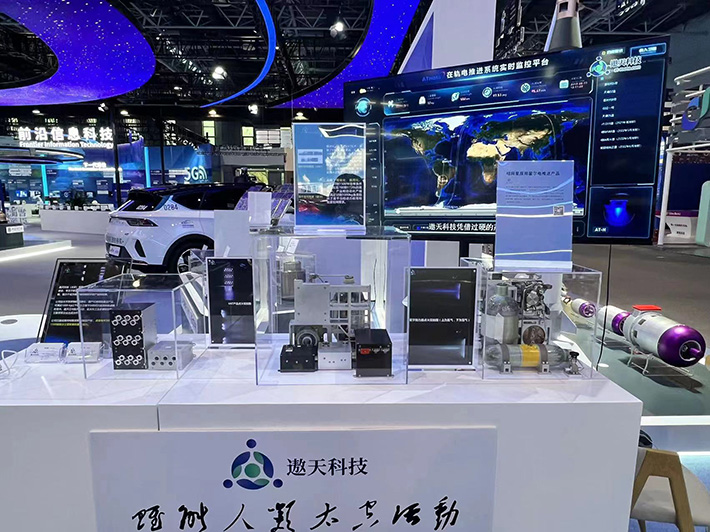|
||||||||||
| Home Nation World Business Opinion Lifestyle ChinAfrica Multimedia Columnists Documents Special Reports |
|
||||||||||
| Home Nation World Business Opinion Lifestyle ChinAfrica Multimedia Columnists Documents Special Reports |
| ChinAfrica |
| A Highland of Vitality |
| Zhongguancun Forum provides a stage for hi-tech players |
| By Li Xiaoyang | VOL. 15 July 2023 ·2023-06-25 |

A full-size humanoid bionic robot is on display at the exhibition centre of the Zhongguancun National Independent Innovation Demonstration Zone during the 2023 Zhongguancun Forum in Beijing, which ran from 25 to 30 May (XINHUA)
Launched at the 2023 Zhongguancun Forum in Beijing in late May, China’s new-generation quantum computing cloud platform Quafu is capable of more than just performing complex computations for scientists.
Its introduction makes quantum computing accessible to those outside the scientific research community, as the technology is expected to be applied in more fields such as logistics in the years to come, Fan Heng, a researcher at the Institute of Physics under the Chinese Academy of Sciences, told the forum.
Quafu’s release was among the highlights of the forum, which ran from 25 to 30 May and gathered 650 enterprises and institutions from around the world. Themed on Open Cooperation for a Shared Future, the event featured more than 150 activities. Its exhibition showcased many innovations in the fields of intelligent manufacturing, green industry, healthcare and digital economy.
Village to valley
The Zhongguancun Forum, founded in 2007, was named after Zhongguancun, often known as “China’s Silicon Valley.” Since the 1980s, the area in northwest Beijing has gradually developed from a village into an electronics industry cluster, and then into the hub of innovation. It is the country’s first national hi-tech industrial development zone and the first national independent innovation demonstration zone.
According to the State Council Information Office (SCIO), over 300 multinational companies have established headquarters and research centres in Zhongguancun, and more than 130 Fortune 500 companies have opened branch offices there. In 2021, exports from the zone rose 46 percent year on year to over 389 billion yuan ($54.7 billion), nearly doubling the 2012.
Last year, 4,244 companies in Zhongguancun each saw annual revenue exceed 100 million yuan ($14.1 million), the SCIO said.
Behind the growth of Zhongguancun is China’s pursuit of scientific and technological progress. According to the Ministry of Science and Technology, the country’s research and development expenditure has expanded from 1 trillion yuan ($141 billion) to 3.09 trillion yuan ($435 billion) over the past decade. Its ranking in the Global Innovation Index moved from 34th place in 2012 to 11th in 2022.

AoTian Technology (Beijing) Co. Ltd. presents its electric propulsion products for satellites at the 2023 Zhongguancun Forum in Beijing, which ran from 25 to 30 May (COURTESY)
Growing players
Beijing Zhongguancun Jingdiao Intelligent Manufacturing Innovation Centre Co. Ltd., one of the forum participants based in Zhongguancun, presented its precise cutting equipment by displaying models assembled with barely visible joins. The company focuses on producing parts of vehicles, medical equipment, electronics and cultural products, which have been exported to countries including Germany, the United States and Malaysia.
“We have developed equipment independently for highly precise engraving. The technology even allows engraving on eggshells,” Huang Luyi, an employee of the company, told Beijing Review.
According to Huang, the company has helped many businesses to produce models in the research and development phase. The technology can also be used to improve product quality. For example, precisely carved metal parts of cosmetic instruments ensure a smoother user experience.
Robots used for surgery, manufacturing and delivery were featured in the exhibition. In 2021, CZ-Robot, a company headquartered in Shandong Province, developed a Metaverse Robot System in partnership with Bristol Robotics Laboratory in Britain. The system, based on technologies including cloud computing, big data and indoor positioning systems, allows users to monitor and control robots remotely. Products with the system built-in have been applied in fields including medical disinfection and logistics.
“Through the system, people can control and check robots several thousand miles away to perform tasks like guiding visitors and disinfecting spaces,” said Fang Hanyuan, the company’s director of public relations.
CZ-Robot is working on developing intelligent robots for senior care. As in-home nursing becomes a trend, the company is exploring new ways to meet the needs of seniors, Fang said.
Technologies for green transition, ranging from hydrogen power to smart solutions for green development, made a splash at the forum. Online retail giant JD.com showcased its 5G-powered solutions for carbon management. According to the company, these solutions help to cut over 20 percent of carbon emissions in the company’s logistics parks and improve the efficiency of their operations by around 15 percent.
More and more Chinese tech firms have been exploring emerging fields in recent years. According to Anhui Guosheng Quantum Technology Co. Ltd., a forum participant, it has developed a machine based on quantum technologies to identify defective products in high-end manufacturing industries, which will help to improve security in industrial production.
Alongside global private spaceflight companies such as the US-based SpaceX, Chinese counterparts are also growing in strength. AoTian Technology (Beijing) Co. Ltd. is the first Chinese private enterprise producing electric propulsion systems, which are applied to reduce the weight of spacecraft and satellites and cut the cost of launches. “We have completed China’s first intelligent production line for commercial electric propulsion products, able to serve 1,500 commercial satellites per year. Our products have been used by more than 30 satellite platforms,” said Fu Lei, AoTian’s vice president of public relations.
According to Fu, his company has worked with enterprises including China Aerospace Science and Technology Corp. and China Aerospace Science and Industry Corp. to develop propulsion products. Starting from the first successful use in 2019, the number of its in-orbit applications has reached 25, the highest among its peers in China.
Joining hands
While showcasing scientific and technological achievements, the forum has also provided a platform for exchange. Shi Yigong, a member of the Chinese Academy of Sciences and president of Westlake University, told the forum that countries should join hands to develop a global technological community to address common challenges such as the energy crunch and climate change. Westlake University, inaugurated in October 2018, is a research-oriented private university in Hangzhou, Zhejiang Province.
He emphasised that international cooperation and self-reliant technological progress can promote each other. China needs to pool more top-notch professionals, especially international ones.
|
||||||||||||
| About Us | Contact Us | Advertise with Us | Subscribe |
| Copyright Beijing Review All rights reserved 京ICP备08005356号-5 京公网安备110102005860号 |